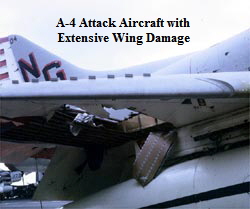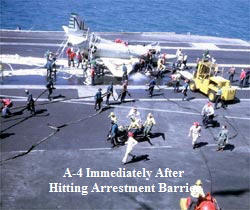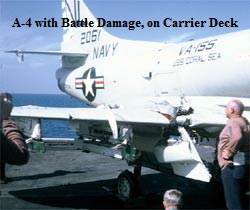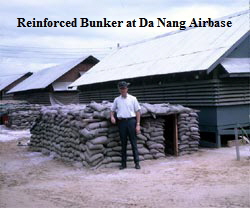|
|||||||
|
Charles R. Foreman As I write this in 2002, It has been thirty-five years since I served as a Navy STRAAD Engineer at Cubi Point NAS in the Philippines. The memories of that experience have not faded. My tour of duty as a STRAAD Engineer spanned seven months, from June through December, 1967. I can say without hesitation that this was an experience of a lifetime for me! Prior to this assignment I had been out of the US only once (to Mexico), and had no military experience. Within a few months I had visited Navy aircraft manufacturers and Navy aircraft repair facilities in seven cities coast-to-coast, visited four Asian countries, and lived at Cubi Point NAS and aboard US aircraft carriers operating in wartime off the coast of North Vietnam. This was the typical experience of all ten STRAAD engineers, and I am sure that it made a lifelong impression on all of us. I arrived at Cubi Point NAS on June 9, 1967 on a Philippine Airlines DC-4 (Navy R&R) flight from Manila. The rainy season had started and it was raining hard as I got off the airplane. Jim Smith was there to meet me, umbrella in hand. He was very glad to see me arrive because it meant that he could soon return to the U.S. and his family. Part of downtown Manila was flooded due to the heavy rains when I arrived from Tokyo on June 7th. My instructions were to go to the U.S. Embassy building where I would catch the Embassy launch and cross Manila Bay to Sangley Point NAS. There I could get an aircraft to take me to Cubi Point. However, there were ten foot swells on Manila Bay and the launch was not running. I tried to contact the STRAAD office at Cubi Point but the telephone lines were out due to the flooding. After two days in a Manila hotel I finally did get through to the STRAAD office. They arranged for the Navy R&R aircraft to pick me up at Manila International Airport. The rainy season in the Philippines lasted until mid-September. During the typical May to October rainy season it rains 125 inches. During the month of June, 1967 it rained 54 inches, which exceeded the previous record! At the end of September the rain abruptly stopped and not another drop fell up to the time I left in December. November through April is the dry season, and January, February, and March are very hot and dry. I was at Cubi Point less than a week when STRAAD Commander Charles Reid sent me out on a C-1 COD aircraft to the USS Bon Homme Richard in the Gulf of Tonkin to evaluate an F-8 and an A-4 Aircraft. That was the first of five trips I made from Cubi Point to aircraft carriers.
During six month my tour of duty, STRAAD averaged about six aircraft in-work at Cubi Point at one time. At one point in September, 1967 there were twelve aircraft in for repair at the same time. Not all of the damage we repaired at STRAAD was battle damage. Many aircraft experienced handling damage which occurred within the very tight confines of wartime aircraft carrier operations. Aircraft slide into one another on slick hanger decks and tow tractors collide with ailerons, horizontal stabilizers, and fuselages. There is one damage experience involving F-8s that I remember most vividly. On November 20, 1967, off the coast of North Vietnam, the USS Oriskany had a catapult malfunction during an afternoon launch. The catapult was subjecting the aircraft to a peak tow force forty to fifty percent higher than the planned tow force setting. When the twelfth aircraft, an F-8C, was launched its catapult keels failed. The pilot, realizing that he had a “cold” cat shot, ejected. The F-8 rolled over the end of the flight deck and came to rest on the boom that extends out beyond the flight deck. The nose landing gear and the inlet duct were damaged. The pilot was not so lucky. Aircraft of that era did not have “zero-zero” ejection seats. The ejection seat trajectory did not take the pilot clear of the ship and he sustained fatal injuries when he hit the catwalk at the side of the flight deck. The eleven other aircraft were grounded for inspection after their mission to North Vietnam.. At the time, I was onboard the USS Coral Sea about ten miles away. At 9 PM I was summoned to the ship’s communication center to take a ship-to-ship radio message. It was the Oriskany’s CAG maintenance officer, and he explained the situation with the catapult overload and F-8 accident. He said that the commander of the Yankee Station carrier group, an Admiral, wanted to know if the eleven aircraft that had received the catapult overload were safe for the 7 AM launch and mission to North Vietnam. He was requesting STRAAD assistance. The STRAAD metalsmith and I were immediately flown in the Coral Sea’s H-1 rescue helicopter to the Oriskany. Flying across ten miles of open ocean in a helicopter on a dark, moonless night and landing on a dark aircraft carrier was a very interesting experience, to say the least! The squadron maintenance personnel, the STRAAD metalsmith, and I spent most of the night inspecting the catapult fittings and keels of the eleven aircraft. We found that the E-1B and the five A-4E’s were undamaged. However, the two-inch diameter steel catapult keel pins of the five F-8C’s were bent. We replaced them with new pins. Because of high design stresses and limited fatigue life in the F-8 catapult keels, I recommended a reduction in the allowable number of cat shots before keel replacement. At 6 AM I went to see the Admiral (the Coral Sea was the Flag Ship) and told him that the aircraft were safe to launch, and explained about the cat shot limitations for the F-8’s. He concurred with my recommendations and the aircraft were launched that morning. In November, an RA-5C Vigilante was unloaded from a carrier at Cubi Point. While on station in the Gulf of Tonkin the aircraft received wing damage in a freak accident. RA-5C’s are large aircraft and were sometimes tied down near the edge of the flight deck so they would not take up precious space in the hanger deck. One night a sailor was practicing maneuvering and aiming an anti-aircraft missile platform, near the RA-5C. The sailor swung the missile around while elevating it and stuck its pointed end into the lower wing skin of the RA-5C. The missile made a hole in the aluminum skin about 4 in. x 10 in. just aft of the front spar. Several hundred gallons of jet fuel ran out on the flight deck. I inspected the damage after the aircraft was brought to the STRAAD hanger. The RA-5C wing skins are made from 7079 aluminum, which has a tendency to delaminate when fractured. I asked the STRAAD technicians to X-ray the damaged area to determine the extent of delamination. Then we cut the skin beyond the delamination area, prevention further delamination. The cleaned-up hole in the skin was about 5 in. x 15 in. and extended to the forward edge of the skin, at the front spar. I designed a 0. 25 in. thick steel repair plate that covered the hole. A pattern of blind fasteners was placed around three sides of the plate. The forward edge picked up the existing spar fasteners. Unfortunately, these were special shoulder bolts and had to be custom made for our repair. The STRAAD machine shop fabricated the bolts from bar stock and I took them to the heat-treat facility at the Subic Bay Ship Repair Facility. I could only hope that the heat treat strength was in the ballpark of what it was supposed to be. The repair plate was installed with plenty of sealant and the wing was fueled. It didn’t leak, so the pilot took the plane up for a test flight. While we were watching, he made some passes across the runway and did some climbs and rolling pullouts. We inspected the wing repair after he landed and found no fuel leaks. I recommended a one-time TRANSPAC ferry flight to Jacksonville NAS (Florida), where the lower wing skin could be replaced. The temporary repair we had installed would restore most of the static strength but would not restore the wing fatigue life. The sailor inflicted very expensive damage to the RA-5C with his missile. To replace the wing skin, the wing had to be removed from the fuselage. That was probably a $250,000 repair (in 1967 dollars). The biggest maintenance item (in terms of labor hours and cost) for carrier aircraft brought into Subic Bay NAS was corrosion control. Corrosion is always a problem for carrier based aircraft because of the salt water environment. However, corrosion is greatly accelerated by Southeast Asia’s warm, humid climate. On several occasions I was called upon to examine aircraft to determine the extent of structural damage due to corrosion. On one occasion we were called to Sangley Point NAS on Manila Bay to inspect two C-45 aircraft (military DC-3) with corrosion problems. This inspection was prompted by the fact that a C-45 had crashed into the jungle in Vietnam, and it was determined that a wing had failed in flight. We found serious corrosion of the outer wing splice angles on the two aircraft and recommended immediate grounding. By far the most exciting experiences for me on the STRAAD tour, the things that really got the adrenaline flowing, were arrested landings and catapult takeoffs on the aircraft carriers. During my STRAAD tour I made five carrier landings and catapult takeoffs. My first two trips from Subic Bay to “Yankee Station” in the Gulf of Tonkin were aboard the older Grumman C-1 carrier onboard delivery (COD) aircraft. Arrestment and catapult g-forces were fairly mild in the C-1, but were much higher in the Grumman C-2 COD with its higher landing and takeoff speeds. The flight to Yankee Station was nearly five hours in the C-1 and about three hours in the C-2 (the distance is nearly 1,000 miles). The C-1 was usually getting low on fuel by the time it arrived at the carrier due to headwinds in that direction. The C-2s had no windows in the passenger/cargo compartment and many times the pilot made no announcements about the impending landing. One could tell by engine sound and aircraft maneuvering that the aircraft was on final approach, but that might last two minutes or fifteen minutes. The suspense really built during that time! The first thing you hear is a loud, metallic “clack” (the tail hook hitting the carrier deck) followed instantly by SLAM!! That is 100 mph to dead stop in about two seconds. It felt like running into a brick wall. Fortunately, the seats in Navy passenger aircraft face aft, so the g-force pushes you into the seat. As soon as the C-2 stops the cargo ramp is lowered. Passengers are led by a sailor directly into the tower to minimize exposure on the flight deck. The wind blast across the deck is very strong, 40 to 50 mph. With this wind environment and jet engines screaming 50 feet away, I had no desire to linger on the flight deck! Catapult takeoff was equally exciting. Catapult g-force for a C-2 is about 3.5g (compared to 5 to 7 g for fighter and attack jets). During the pre-launch briefing, you are told to tighten your seat harness straps very tight, and remove glasses and shirt pocket items. These could become high-speed projectiles during catapult. You can feel the aircraft driving into the nose gear tow fitting, then the aircraft jerks as partial catapult force is applied to pre-load the tow bar and hold-back fitting. The engines are screaming at full power and the prop sound changes as full takeoff pitch is applied. At this point it is only seconds to launch, and the suspense and excitement peaks. Suddenly, it feels as if you have been shot out of a giant sling-shot. In three seconds you are off the carrier and flying. Since there are no windows, you know after a few seconds that you are safely climbing only because you haven’t crashed into the ocean. In addition to the trips to carriers at Yankee Station, I made three trips to Danang, South Vietnam to inspect damaged Marine aircraft. Travel from Cubi Point NAS to Danang was by means of a Marine C-130 that flew twice a week from Okinawa to Cubi Point to Danang. Most of the aircraft I inspected at Danang were F-8Cs with small caliber projectile damage. Once, the Marines flew me to Chu Lai to inspect an A-6. Twice I went to the large helicopter base at Marble Mountain near Danang to inspect damaged helicopters. Trips to Da Nang were always interesting because there was a war going on over the mountains just a few miles away. The STRAAD repair technicians lived in two hutches (one-room barracks with screened upper walls) in the Marine compound at the Da Nang Airbase. On two occasions I had to go to downtown Da Nang to a Navy communications center to send a message. There were Marines in sandbag bunkers with machine guns on nearly every street corner. A Huey gunship would sweep down the Da Nang river about every fifteen minutes. At night I could hear the distant sounds of battle beyond the mountains. On one trip to Da Nang, I just missed some direct involvement in the war. I flew into Da Nang on a Tuesday, completed my damage inspections, and left at 12:00 noon on Saturday on the C-130 flight to Cubi Point. At midnight that night the Vietcong bombarded the airbase with 100mm Russian rockets. The attack lasted for nearly two hours. On the Air Force side of the base several airmen were killed and about ten aircraft destroyed. The ammunition dump on the Marine side of the base was hit and it went up with a thunderous roar and showered the area with burning shrapnel. If the Saturday C-130 flight had been canceled (as it had been on my previous trip) I would have been about four blocks from the exploding ammunition dump!
On my first visit to Da Nang I was told about the two F-8s which had taken off with outer wings folded, as mentioned previously by Jim Smith. It is difficult for the pilot to see the outer wings, particularly at night. In the second incident, which occurred at night, the pilot taxied with the wings folded and forgot to put them down for takeoff. The pilot reported later that he used most of the 10,000 foot runway getting airborne. The tower did not notice his problem because it was dark. By the time the pilot discovered his error it was too late to abort the takeoff. He continued to climb, got some altitude, and then pushed the nose over to get zero-g so that he could actuate the outer wings to the down position. Flight with the outer wings folded is possible in an F-8 only because the ailerons are inboard of the wingfold. The outer panels have leading edge flaps but no trailing control surfaces. This incident, taking off with the wings folded, has occurred on other occasions in the flight history of the F-8. The first incident occurred in the early 1960’s at Naples, Italy. To me it is remarkable that the F-8 could take off near maximum gross weight with that significantly reduced wing area! During the Vietnam war, the two Navy carrier based fighter planes were the F-8 Crusader and the F-4 Phantom. The F-4 had better acceleration, slightly higher top speed, and could carry more ordnance than the F-8. However, the F-8 was more maneuverable and carried machine guns (the F-4 carried missiles but no guns).The F-8 was highly regarded for its capabilities and was considered by Navy pilots to be the “fighter pilot’s fighter”. A few days before I left the Philippines, I witnessed a significant Vought milestone. In early December, 1967 the USS Ranger pulled into port at Cubi Point with the first Squadron of A-7 attack aircraft. These new Vought aircraft would distinguish themselves during the remainder of the war for their superior light attack capability. Charles R. Foreman
|
|||||
|
Personal stories of their STRAAD tour experiences: Ed Grube |
|||||

 Most of the damaged aircraft that I worked on were A-4s and F-8s, with repair dispositions also made on F-4B, RA-5C, A-1H, A-6B, EA-1F, and E-1B aircraft and on one UH-2A helicopter. I inspected and dispositioned fourteen F-8C’s and F-8E’s and eight A-4B’s, C’s, and E’s. Most damage to Vought F-8s was from small caliber projectiles or shrapnel. The A-4s were able to return to the carriers in the Gulf of Tonkin with some spectacular wing damage. As a slower attack aircraft, the A-4s were quite often hit with large caliber AA projectiles. When these projectiles hit the wing, the hydraulic ram pressure would tear off large pieces of the relatively thin (0.063 inch aluminum) wing skin. However the wing was very rugged and the aircraft remained flyable with large damage, as illustrated by Figure 7. This aircraft was repaired by STRAAD at Cubi Point, and exception to the 400 man-hour limit.
Most of the damaged aircraft that I worked on were A-4s and F-8s, with repair dispositions also made on F-4B, RA-5C, A-1H, A-6B, EA-1F, and E-1B aircraft and on one UH-2A helicopter. I inspected and dispositioned fourteen F-8C’s and F-8E’s and eight A-4B’s, C’s, and E’s. Most damage to Vought F-8s was from small caliber projectiles or shrapnel. The A-4s were able to return to the carriers in the Gulf of Tonkin with some spectacular wing damage. As a slower attack aircraft, the A-4s were quite often hit with large caliber AA projectiles. When these projectiles hit the wing, the hydraulic ram pressure would tear off large pieces of the relatively thin (0.063 inch aluminum) wing skin. However the wing was very rugged and the aircraft remained flyable with large damage, as illustrated by Figure 7. This aircraft was repaired by STRAAD at Cubi Point, and exception to the 400 man-hour limit.
 One afternoon onboard the USS Coral Sea I was watching the recovery of aircraft returning from a bombing raid on North Vietnam. One A-4 circled the carrier rather than making a direct landing approach. Then I observed that the A-4 had only one main gear down. The deck crew quickly erected the emergency arrestment barrier, and I watched as the plane approached for landing. The pilot did not catch the arrestment cables and crashed into the barrier. This is a very sudden stop but much better than the alternative! I managed to get two photos of the event. In the first, taken seconds after the landing, the pilot is being hauled away on a stretcher.
One afternoon onboard the USS Coral Sea I was watching the recovery of aircraft returning from a bombing raid on North Vietnam. One A-4 circled the carrier rather than making a direct landing approach. Then I observed that the A-4 had only one main gear down. The deck crew quickly erected the emergency arrestment barrier, and I watched as the plane approached for landing. The pilot did not catch the arrestment cables and crashed into the barrier. This is a very sudden stop but much better than the alternative! I managed to get two photos of the event. In the first, taken seconds after the landing, the pilot is being hauled away on a stretcher.  He was semi-unconscious from the arrestment force but otherwise uninjured. In the second, taken a short while later, shows the damage from an explosive round that hit the right hand wheel well area. The tire and landing gear actuator hydraulic lines were ruptured.
He was semi-unconscious from the arrestment force but otherwise uninjured. In the second, taken a short while later, shows the damage from an explosive round that hit the right hand wheel well area. The tire and landing gear actuator hydraulic lines were ruptured.
 A couple of weeks later I talked to one of my STRAAD airframe mechanic friends who had been asleep in the STRAAD hutch when all hell broke loose. He said that they all jumped into an adjacent sandbag bunker and huddled there for the duration of the attack. He said that were very frightened because they expected a rocket to land right in the middle of them at any moment! The problem was that the bunkers did not have a top. The bunkers were only a rectangle of low sandbag walls. He said that the next day everyone pitched in to dig the bunker deeper and put a sturdy beam and sandbag roof on it. In any event, I am glad that I missed that excitement! Figure 10 shows the much improved sandbag bunker next to the STRAAD hutch.
A couple of weeks later I talked to one of my STRAAD airframe mechanic friends who had been asleep in the STRAAD hutch when all hell broke loose. He said that they all jumped into an adjacent sandbag bunker and huddled there for the duration of the attack. He said that were very frightened because they expected a rocket to land right in the middle of them at any moment! The problem was that the bunkers did not have a top. The bunkers were only a rectangle of low sandbag walls. He said that the next day everyone pitched in to dig the bunker deeper and put a sturdy beam and sandbag roof on it. In any event, I am glad that I missed that excitement! Figure 10 shows the much improved sandbag bunker next to the STRAAD hutch.